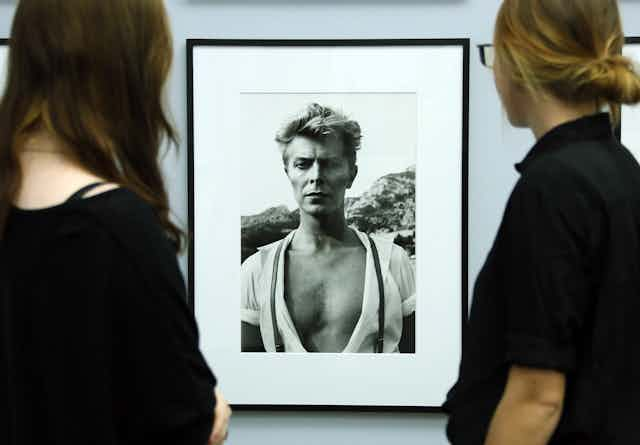Rebel Rebel, you’ve torn your dress
Rebel Rebel, your face is a mess
Rebel Rebel, how could they know?
Hot tramp, I love you so!
Our lives are often shaped and made meaningful by the stars and celebrities who enter them. Our bedrooms can become shrines of longing, identification and desire, and the friends we make and the lovers we take can gravitate around the famous figure we together so admire.
For the writers of this piece, David Bowie is one such star-man: his music, lyrics, writings and performances are felt to wrap themselves around their youth, their rebellion, their hurt, and their love.
When Bowie sang of aliens, cross-dressed, or emptied himself of colour and light, he demonstrated the power that music, fashion and performance can have in creating the landscape of endless possibility for those who danced in his long if glittering shadow.
That Bowie has influenced many lives is undeniable. For more than four decades he has represented restless change, social rebellion and artistic innovation.
Ziggy partied and died too young. Aladdin Sane swam in his own melancholia and depression. The beautifully suited Thin White Duke overdosed on coke and power. And one-eyed Halloween Jack became a fairground wild animal of unlimited potentiality.
In each image, one witnesses the crystalisation of difference, of alienation and marginalisation, and yet within each strutting incarnation is also an open, carnal defiance of artistic and social norms.
Few figures have been able to straddle the art/popular culture nexus as well as David Bowie.
Few figures have demonstrated so exactly the art of rebellion.
In the terrible shocks and jolts that emerge from having to grow up into a banal and conforming world, Bowie gave each of the writers the means to exist freely, openly, and with an unearthly politics that allowed them to challenge gender and sexual norms.
Exhibiting the exhibitionist
The question is often asked – just who is Bowie? The answer is never a simple one: his polysemy and contradictory and challenging masks render him a figure of diversity and confusion – which is of course part of his attraction – and mean he simply cannot be defined. He exists in a carnival of exhibitionism, something that continues to this day.
His cultural and artistic currency is presently at an all time high with his first album in almost a decade. The Next Day (2013) reviewed as one of the greatest rock comebacks ever; the release of a series of portentous music videos that recall and reflect upon his artistic career; the recently released, Sue (Or In A Season Of Crime) from his compilation album spanning 50 years of recorded work on Nothing Has Changed (2014), and the record-breaking David Bowie Is global exhibition tour, which opens at the ACMI in Melbourne on July 16.

Now seen by more than 1 million people worldwide, the exhibition will include more than 50 legendary costumes, original stage set designs, handwritten lyric sheets, album artwork, rare film, video and photographs, and interviews with collaborators. The David Bowie Is program of events incorporates film, live talks, music, live performances and other creative works. It is the must-see event of the winter season.
Nested within this cornucopia of exhibition delights is a two-day multidiscipline symposium, The Stardom and Celebrity of David Bowie (July 17-18).
The symposium – at which both writers of this piece are participating – explores an array of topics including Bowie’s most interesting artistic collaborations; his performative history in mime, theatre and film; the poetic sensibility of his cut and mix lyrics; and fashion and artistic trends and their influences on his own unmasked “transgressions” of sexuality, race and class.
In addition, a number of creative artists will respond to Bowie’s work through their own practice. Installation artist Jamie O’Connell will calibrate a photocopier so that it counts the number of times a piece of Bowie memorabilia is auctioned and bought in the world. In this piece, Bowie becomes the star who is sold to the world.

It is easy to be mesmerised by Bowie’s powerful visuality in a media saturated world where the role of the ocular is increasingly essential to thinking across a range of motifs. We sometimes see too much but are asked to feel too little. Bowie, by contrast, turns seeing upside down, and wraps the strings of feeling around his envisioned worlds and characters.
A fascinating artist, Tanja Stark, draws on visual expression to present her creative work that places strong emphasis on Bowie’s visionary opus. Visitors are offered a walk-through sonic and visual labyrinth as a means to explore the archetypal theme of the profound personal and sometimes mysterious journey. Stark’s work acts to reflect the impressions left by Bowie’s presentation of the scintilla sublime or those mesmerising moments which make one swoon.
By way of concentrating research debate and critical analysis around Bowie’s music, art and video work, the symposium offers a full circumnavigation of the significant implications of his incredible oeuvre, and deals with notions of “stardom” more broadly.
So, who is David Bowie?
I’m not a prophet
or a Stone Age man
Just a mortal
with the potential of a superman
I’m living on
David Bowie Is will be at ACMI, Melbourne, from July 16 to November 1. Details here.

